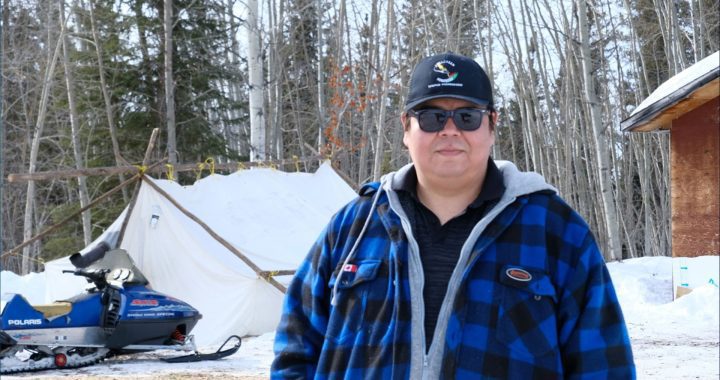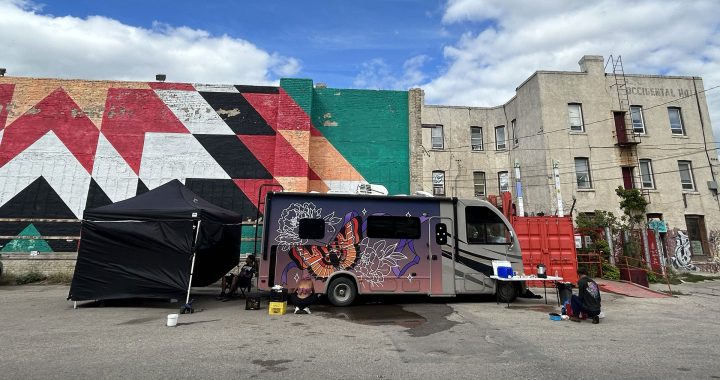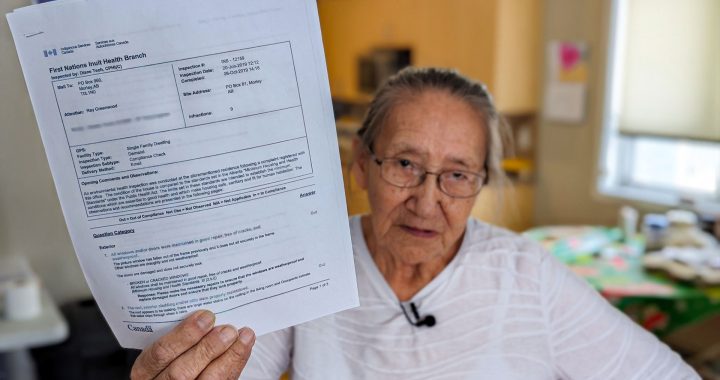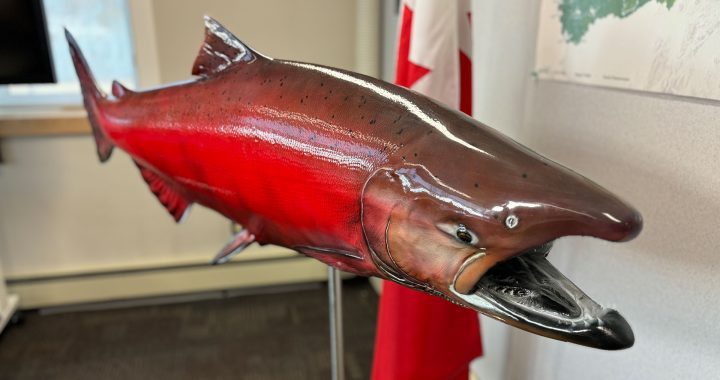(A reclamation site outside Fort McKay First Nation with a Syncrude plant in the background. Photo:Brandi Morin/APTN)
Brandi Morin
APTN National News
FORT MCKAY FIRST NATION — When Melinda Stewart grew up in Fort McKay she used to fall asleep to the sounds of the frogs croaking outside.
Now, Stewart puts her children to bed to the pre-recorded sounds of frogs and nature so that they don’t have to listen to the continuous booming from the nearby tailings ponds.
“Now, my children, that’s what they’re used to, listening to cannons going off all night,” said Stewart.
She fears that one day her children will become “textbook Aboriginals” because their homelands are disappearing. Tears well up in her eyes as she expresses her lament over the destruction of the environment caused by oil sands activity.
“I think in 50 years, our children are going to learn from a textbook how to be native. When I take my children hunting or fishing, if there’s something nice, I tell them to take a picture because when we come back it might not be there…”
Fort Mckay is completely surrounded by industrial development and it’s getting closer. So far, they’ve survived, but the long term effects of pollution and other contaminants haven’t yet been fully revealed.
Governments and industry talk about reclamation, yet in the decades since oil extraction began, only 0.15 per cent of land has ever been reclaimed.
Currently an area the size of Switzerland is being mined with ambitions to further expand production.
Alvero Pinto, director of sustainability at Fort McKay said there’s no way the land can ever be reclaimed to its original state. He should know, he’s a mining engineer who once worked for some of the biggest mining companies in the world.
Once during a meeting with industry representatives, one of the presenters boasted that industry can reclaim the land and put it back together better than it was before.
“And I said, my friend, never make this statement especially to a First Nation because there is no way, nobody can reclaim the land or put back the environment in a better state than it was before,” said Pinto.
There is no player at http://bcove.me/us1e6jsb.
The community finds some comfort, however in working with industry to incorporate traditional knowledge to reclamation plans. Elders offer advice in exchange for the hope that industry will take it into consideration during the restoring process.
Despite all that’s been lost there is one last area of solace that the people of Fort McKay are holding onto. Moose Lake is a part of the reserve located approximately 50 km northwest of Fort McKay and is relatively untouched by industry.
Moose Lake, is how people cope, said Dayle Hyde, Fort McKay education director.
“It is a sanctuary. It feels like home, hasn’t changed much, and still looks the same as 100 years ago. When people talk about it they say it’s a good place. They heal when they go there.”
It is considered sacred to the people of Fort Mckay, sheltered from the fast pace of the world. It’s a place to go to practice culture and traditions, a refuge of peace and quiet, connected to their ancestors.
There is no player at http://bcove.me/5qg14cv7.
(Video of Moose Lake courtesy: Fort McKay First Nation)
“It’s not just a place we want to go camping some weekends,” said Elder Clara Mercer.
“Our people live there year round until their children become of age to go to school. Today Moose Lake is all we have left to teach our children and grandchildren our traditional way of life and culture…but industry is coming.”
The area surrounding the lake is full of oil and dozens of oil companies are eager to get at it.
In 2013, Fort McKay filed an appeal with the Albert Energy Regulator (AER) seeking environmental protection for Moose Lake over a planned site nearby. They requested a 20 km buffer zone be set up, however the AER sided with industry and gave the go ahead.
But afterward the developer approached Fort McKay and offered a back deal, with business and financial opportunities, including an 8km buffer zone around the lake.
Then, just this past March the Alberta Government signed a letter of intent promising to develop an access management plan for the area surrounding the lake.
Despite industry closing in on Fort McKay, Hyde believes the people are still deeply connected to the land, water and animals.
Some people have chosen to move away to avoid the environmental effects, but when industry does eventually leave, Fort McKay will still be there. Because it is still a beloved home to many.
“I think Fort Mckay is here to stay. This has been happening for years now and we’re still here.
We don’t know what’s going to be left but we’re going to deal with it. I think one of the biggest strengths of the people of Fort McKay is that despite the hardships and challenges we’ve faced, we continue to adapt and prevail,” said Hyde.
Chief Jim Boucher believes one of the keys to the future is education, job opportunities and entrepreneurialism.
“I think Fort McKay is going to be all over the world. We have teachers, police officers, good administrators. Our people are going to be strong and self-sufficient. I’m really optimistic for our community because we have so much potential and ability. It’s up to us to take that opportunity and make that happen.”
But Elder Barb Faichney said survival is dependent on striking a balance between nature and industrial activity, however that balance is exceedingly out of proportion due to overdevelopment.
“We will say it’s not worth it. But the oil companies will say, ‘yes it was worth it- we walked all over those Indians, but we made money,’” said Faichney.
“It shouldn’t have to be like that.”
@songstress28









